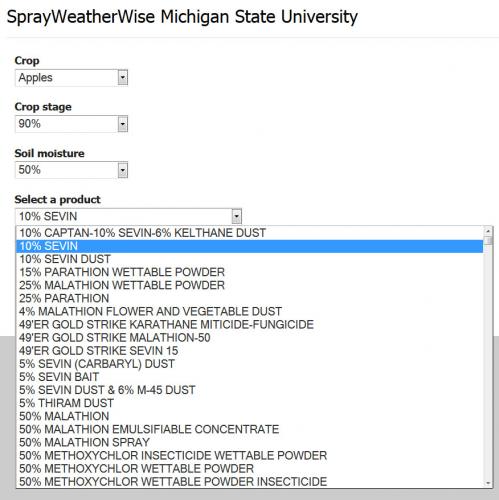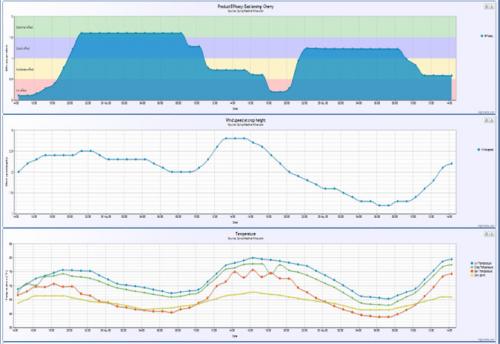SprayWeatherWise: New weather forecasts for spray operations
SprayWeatherWise, a new weather forecast product associated with Enviro-weather, provides growers with local, detailed forecasts of both weather and spray compound efficacy.
Enviro-weather is partnering with SprayWeatherWise/Agro Weather Services to offer Michigan growers a new tool to identify optimal times for pesticide applications. Enviro-weather provides an online suite of weather-based applications to help growers make good IPM decisions. Besides local and regional summaries on weather (past, present and forecast), Enviro-weather includes crop, pest and disease models that predict the appearance of pests and helps growers time their scouting and pesticide applications more efficiently.
Now Enviro-weather is excited to offer access to a new application that helps growers determine when to spray for greatest efficacy. SprayWeatherWise, an internet-based decision-support system developed by two scientists from the Netherlands, Joost Nieveen and Erno Bouma, estimates the effect of weather on pesticide efficacy during upcoming 48-hour periods based on detailed weather forecast conditions. A number of crops, herbicides, fungicides and insecticides are included in the database. Users specify the location by zip code, crop, crop growth stage, soil moisture conditions and the pesticide to be sprayed. The program uses forecast weather conditions from that location and simulates the interaction of the pesticide with the plant and the environment to determine efficacy over time. Weather conditions are taken from a National Weather Service operational forecast model run twice per day out 48 hours into the future.
Pesticides are affected directly and indirectly by weather conditions. The most obvious is precipitation, which, according to Michigan State University Extension, can remove a good deal of the product from the plant surface. Efficacy may be influenced by temperature – the precise effect depending on the product. Temperature also increases the activity of insects, which may affect efficacy, especially with contact insecticides. Solar radiation may degrade some products. Uptake by the plant is determined in part by temperature and relative humidity. The growth stage of the plant and its canopy type modifies the microclimate and thus affects deposition and uptake of the pesticide. Weather affects plant physiology, which in turn affects uptake and transport within the plant. All these are simulated in SprayWeatherWise.
SprayWeatherWise will be offered to users free of charge on a trial basis in 2013 for a limited number of crops (apples, blueberries, cherries, grapes, pears and potatoes). We are planning to offer a more comprehensive version in subsequent years on a subscription basis.
If you are interested in trying SprayWeatherWise, you can access the SprayWeatherWise website.
After bringing the site up, you will be asked to provide information specific to your cropping situation through a series of pull down menus (Figure 1). Approximate estimates are fine for the crop stage (% of the season) and soil moisture. After filling in the five required pieces of information, click on Submit.

Figure 1. SprayWeatherWise users must specify several input variables from pull down menus, including crop type (top), the current crop growth stage in percent (second from top), current (estimated) soil moisture levels as a percent of field capacity (third from top), the product to be sprayed (fourth from top), and zip code (bottom, not shown).
The program will provide you with a page of six panels depicting forecasts of major variables at hourly intervals over the 48-hour period. These include compound efficacy, wind speed at crop height, air, crop canopy, soil and dew point temperatures, crop leaf wetness status, rainfall (probabilities and amounts) and evapotranspiration and soil moisture. An example of the top three panels is given in Figure 2. As illustrated in the figure, spray efficacy conditions can and do change dramatically during the course of a day. While the output is not perfect (no forecast is), it still provides users with a sound estimate of conditions during the upcoming two days which can be used for planning and, hopefully, for making better informed decisions.

Figure 2. Example of SprayWeatherWise forecast output for East Lansing (in this case, Imidan 50-WP on cherry) for compound efficacy (top), wind speed (middle), and air, crop canopy, soil and dew point temperatures (bottom). Time is given on the horizontal axis while variable values are on the vertical. For the spray efficacy (top), values highlighted in green are for forecast optimal conditions, purple is for good conditions, yellow is moderately effective and salmon is poor or ineffective.
Users will be asked to take an end of season survey to help us gauge usefulness and to provide feedback, constructive criticism, etc. For more information, please see the Enviro-weather website or contact us at eweather@msu.edu or 517-432- 6520.



 Print
Print Email
Email


